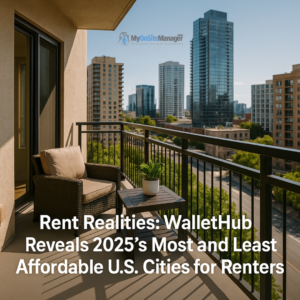Renters across the United States are facing an increasingly complex financial landscape. While inflation has cooled and wages have seen moderate growth, rent prices in many areas remain persistently high—forcing Americans to spend a larger share of their income just to keep a roof over their heads.
To help bring clarity to this issue, WalletHub recently released a 2025 study analyzing more than 180 U.S. cities to identify where renting is most affordable. Using a simple but powerful metric—median annual gross rent as a percentage of median household income—the study reveals which cities offer the best and worst value for renters. The results, as reported by CNBC, showcase stark differences across regions and provide a wake-up call for policymakers, renters, and landlords alike.
How WalletHub Ranked the Cities
WalletHub’s approach to measuring rent affordability was grounded in an essential financial principle: housing should ideally not exceed 30% of a household’s gross income. This threshold is widely used by housing experts to determine whether a person is “rent-burdened.” Anything above that puts financial stress on individuals and families—limiting their ability to save, invest, and enjoy a good quality of life.
Using this formula, WalletHub calculated the rent-to-income ratio for each city based on available 2023-2024 Census data and real estate market analytics. The resulting rankings are both insightful and, in some cases, surprising.
Top 10 Most Affordable Cities for Renters in 2025
In these cities, rent accounts for less than 18% of the average resident’s income—well below the national rent burden threshold.
-
Bismarck, North Dakota – 15.34% of income spent on rent
-
Sioux Falls, South Dakota – 15.95%
-
Cheyenne, Wyoming – 16.09%
-
Cedar Rapids, Iowa – 16.36%
-
Fargo, North Dakota – 16.65%
-
Charleston, West Virginia – 16.70%
-
Casper, Wyoming – 16.72%
-
Overland Park, Kansas – 16.81%
-
Juneau, Alaska – 17.45%
-
Anchorage, Alaska – 17.76%
These cities—mainly located in the Midwest and Mountain West—benefit from a combination of stable housing markets, lower population density, and moderate wage levels. In Bismarck, for example, the strong local economy and controlled housing supply contribute to a more balanced rental ecosystem.
For renters seeking stability and a higher standard of living, these cities offer compelling opportunities—particularly for remote workers, retirees, or young professionals looking to build savings.
Bottom 10 Least Affordable Cities for Renters in 2025
Conversely, these cities exceed the 30% affordability threshold—making them some of the most challenging rental markets in the country:
-
Miami, Florida – 33.48%
-
New Haven, Connecticut – 32.18%
-
Bridgeport, Connecticut – 29.8%
-
Detroit, Michigan
-
Glendale, California
-
Newark, New Jersey
-
Hialeah, Florida
-
Los Angeles, California
-
Jersey City, New Jersey
-
Philadelphia, Pennsylvania
These urban centers are struggling with high housing demand, stagnant income growth, and limited rental inventory. Miami, in particular, continues to experience a dramatic post-pandemic population boom—pushing prices up while wages fail to keep pace.
In Connecticut, despite a slight statewide rent decrease of 0.3% year-over-year (according to Zillow), two cities—New Haven and Bridgeport—remain among the least affordable in the U.S. This is especially notable considering the average rent in Connecticut is $1,788 per month.
David Rich, president of the Housing Collective, highlighted the concern in a recent interview: “Rents in Fairfield County have increased 37% to 38% over the last three years. That’s a major problem for affordability, and it’s a trend that’s not slowing down.”
Regional Patterns: The Midwest vs. Coastal Cities
One of the biggest takeaways from the report is the growing affordability divide between the Midwest and the coastal cities. While cities like Sioux Falls and Cedar Rapids maintain a balanced housing economy, major metropolitan areas—particularly in Florida, California, and the Northeast—continue to push renters to the financial edge.
This geographic disparity reflects broader trends in housing supply, income inequality, and migration. Remote work has allowed some renters to relocate to more affordable cities, but that’s not always an option—especially for workers tied to high-cost markets.
Why Rent Affordability Is More Than Just Numbers
When rent eats up over 30% of your income, it doesn’t just limit your ability to save—it can lead to long-term financial stress, difficulty securing credit, and limited mobility. Rent-burdened households are less likely to buy homes, invest in education, or recover from emergencies.
Meanwhile, in cities with lower rent burdens, people often enjoy greater freedom, economic flexibility, and quality of life. They can put money toward future goals, whether it’s owning a home, saving for retirement, or building a business.
Looking Ahead: What This Means for Renters and Policymakers
The WalletHub rankings serve as both a guide and a warning. For renters, it provides actionable insight into where housing is more manageable. For local governments and housing authorities, it emphasizes the need to:
-
Increase affordable housing supply
-
Improve wages relative to cost of living
-
Expand renter protections
-
Support inclusive economic development
If current trends continue unchecked in the least affordable cities, we could see increased out-migration, economic stagnation, and worsening housing insecurity. Conversely, cities that prioritize affordability may attract more residents, businesses, and long-term investments.
Conclusion: Choosing Where to Live Is Now a Financial Strategy
In 2025, deciding where to rent is no longer just about lifestyle—it’s a financial decision with long-term consequences. Thanks to reports like WalletHub’s, renters can make more informed choices, and policymakers can better understand the challenges facing their communities.
If you’re currently renting or planning a move, use this data to assess your financial position and explore opportunities in cities that won’t stretch your budget thin.
Source: CNBC – WalletHub: Cities with the Most Affordable Rent (April 17, 2025)

